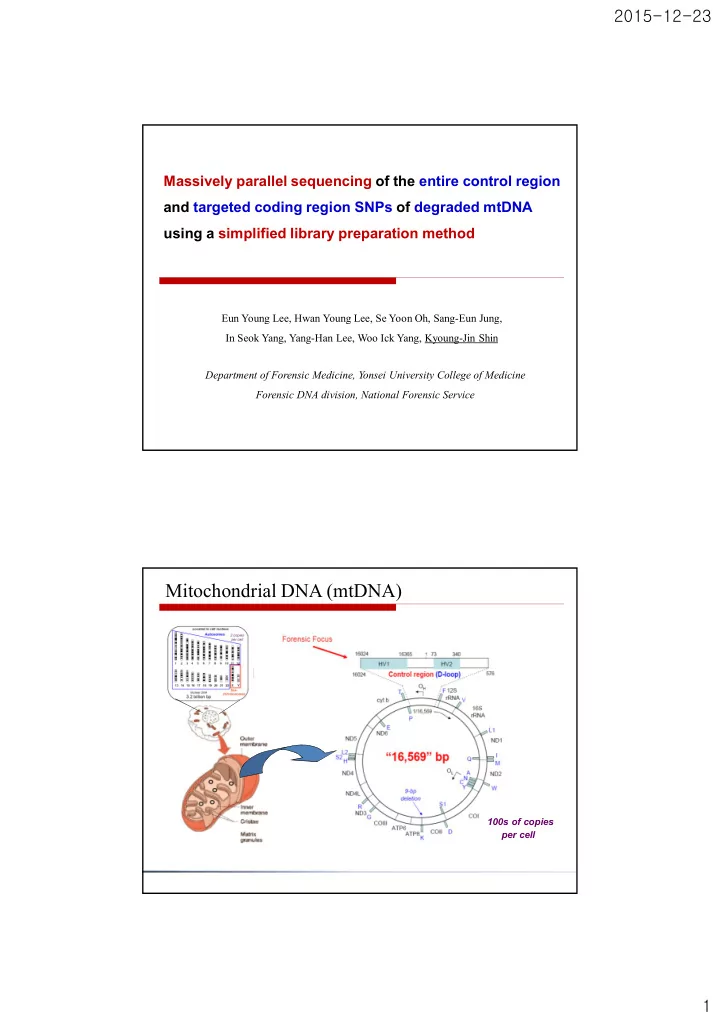

2015-12-23 Massively parallel sequencing of the entire control region and targeted coding region SNPs of degraded mtDNA using a simplified library preparation method Eun Young Lee, Hwan Young Lee, Se Yoon Oh, Sang-Eun Jung, In Seok Yang, Yang-Han Lee, Woo Ick Yang, Kyoung-Jin Shin Department of Forensic Medicine, Yonsei University College of Medicine Forensic DNA division, National Forensic Service Mitochondrial DNA (mtDNA) 100s of copies per cell 1
2015-12-23 Introduction Ø Importance of mitochondrial hyper-variable (HV) regions and coding region SNPs analysis in degraded samples identification Ø Limitation of existing methods for mtDNA analysis using degraded samples Ø Next-generation sequencing (NGS) is expected to be useful technique to analyze mtDNA effectively Ø More simple library preparation method is needed to easily access NGS analysis Object Ø Development of library preparation system for mtDNA sequencing § Construct a multiplex PCR system - Amplification of entire control region and targeted coding region SNPs - Small-sized amplicons (<250 bp) - Simultaneous amplification of coding region SNPs specific to global and East Asian haplogroups § Devise a simple library preparation method Ø Validation of devised NGS system for mtDNA analysis § Test using artificially or naturally degraded DNA samples 2
2015-12-23 Multiplex PCR design for mtDNA sequencing Ø Control regions (6 amplicons from 2 multiplex PCRs) ⇒ Amplicon size range; 229 ~ 242 bp Ø Coding region SNPs (22 amplicons from 2 multiplex PCRs) ⇒ Amplicon size range; 101 ~ 135 bp Global mtDNA haplogroups 3
2015-12-23 Multiplex PCR design for mtDNA sequencing Ø Selected 32 coding region SNPs and haplogroups Simplify library preparation Fragment genomic DNA ① (PCR product) ② End repairs ① ③ Beads purifications ④ Adenylate 3’ ends ② ⑤ Beads purifications ⑥ ⑦ Beads purifications Beads purifications 4
2015-12-23 Strategy for NGS library preparation Ø 1 st PCR; Specific to mtDNA sequence Strategy for NGS library preparation Ø 2 nd PCR; Specific to adaptor sequence 5
2015-12-23 Materials and Methods Ø Workflow of library preparation and NGS run 1 st PCR reaction ; Midiplex I/II, mtSNP I/II 2 nd PCR reaction ; Adding indices Bead purification Library quantification Library pooling NGS (Illumina Miseq) Materials and Methods Ø 1 st PCR condition Thermal cycling Reaction mixture Midiplex I/II mtSNP I/II 95 ℃ 11 min 10x STR buffer 2.0 ul 2.0 ul 94 ℃ 20 sec Primers Adjusted conc. Adjusted conc. 56 ℃ 60 sec X 25 cycles Gold Taq polymerase 0.3 ul (1.5 U) 0.6 ul (3.0 U) 72 ℃ 30 sec *Template 100 pg or 2 ul 100 pg or 2 ul 72 ℃ 7 min Fill up to with dH 2 O 20.0 ul 20.0 ul 4 ℃ forever *Template; 100 pg of degraded control DNA (2800M, 9947A and 9948) 2 ul of extracted DNA from bone Ø 2 nd PCR condition Reaction mixture Thermal cycling 95 ℃ 15 min 10x STR buffer 2.0 ul 94 ℃ 20 sec Index 1 2.0 ul 59 ℃ 30 sec X 15 cycles Index 2 2.0 ul 72 ℃ 30 sec Gold Taq polymerase 0.2 ul (1.0 U) 72 ℃ 7 min **Template 2.0 ul 4 ℃ forever Fill up to with dH 2 O 20.0 ul **Template; 1.0 ul of 1/100 diluent of 1 st PCR I product + 1.0 ul of 1/100 diluent of 1 st PCR II product 6
2015-12-23 Materials and Methods Ø DNA samples § Artificially degraded standard DNAs (2800M, 9947A and 9948) § 10 DNAs extracted from old skeletal remains Ø Generation of library by 2-step PCR § Midiplex I/II (Average size; 372 bp) § mtSNP I/II (Average size; 257 bp) Template; 2800M DNA Materials and Methods Ø Library quality control § Library quantification using using KAPA library quantification kit § Library QC using Bioanalyzer Ø Library pooling and NGS run § 28 amplicons/sample ; 6 amplicons from Midiplex PCR + 22 amplicons from mtSNP PCR § 10 samples/run § NGS on Illumina platform ; MiSeq Reagent Nano Kit v2, 500 Cycles (2x250 bp) 7
2015-12-23 Results Ø The obtained data yield per sample Read count distribution of 2800M control DNA Ø Coverage for 22 amplicons for 32 coding region SNPs Ø Coverage for 6 amplicons on mitochondrial control region 8
2015-12-23 Read count distribution of a skeletal sample Ø Coverage for 22 amplicons for 32 coding region SNPs Ø Coverage for 6 amplicons on mitochondrial control region Materials and Methods Ø NGS data analysis Miseq run; FASTQ Bowtie 2; Align with rCRS SAMtools; Convert to BAM VarScan 2; Variant calling IGV; Confirm calling results Hg designation; Refer to PhyloTree Build 16 9
2015-12-23 mtDNA sequence and haplogroup Sample ID Control Region Coding Region Haplogroup 16519C 2800M 8860G H1c 152C 263G 315.1C 477C 16311C 16519C 9947A 8448C 8860G H11 93G 195C 214G 263G 309.1C 309.2C 315.1C 16223T 16362C 16519C 4883T 7028T 8414T 8860G 9540C 9824A SR0022 D4b2b 73G 150T 194T 205A 263G 315.1C 489C 523d 524d 11719A 12705T 14766T 14783C 16223T 16231C 16362C 4883T 7028T 8414T 8860G 9540C 11696A SR0023 D4j 73G 263G 315.1C 489C 11719A 12705T 14766T 14783C 16183C 16189C 16335G 16527T SR0026 1005C 6392C 7028T 8860G 11719A 14766T F2 73G 152C 249d 263G 309.1C 309.2C 315.1C 16223T 16290T 16319A 16362C 4824G 7028T 8459G 8794T 8860G 11719A SR0027 73G 152C 207A 235G 260A 309.1C 309.2C 315.1C A15 12705T 14766T 523d 524d … … … … 16187T 16223T 16290T 16319A 16519C 4824G 7028T 8794T 8860G 10670T 11719A SR7041 A5a 73G 235G 263G 309.1C 315.1C 523d 524d 12705T 14766T Summary Ø Construction of multiplex PCR system to amplify entire control regions and targeted coding region SNPs of mitochondrial DNA Ø Development of simple library preparation system for mtDNA NGS analysis Ø Demonstration validity of devised NGS system for analysis of mitochondrial DNA sequences using degraded samples 10
2015-12-23 Acknowledgement This research was supported by a fund (NFS2014DNA06) from the Forensic Research Program of the National Forensic Service, Korea. 11
Recommend
More recommend